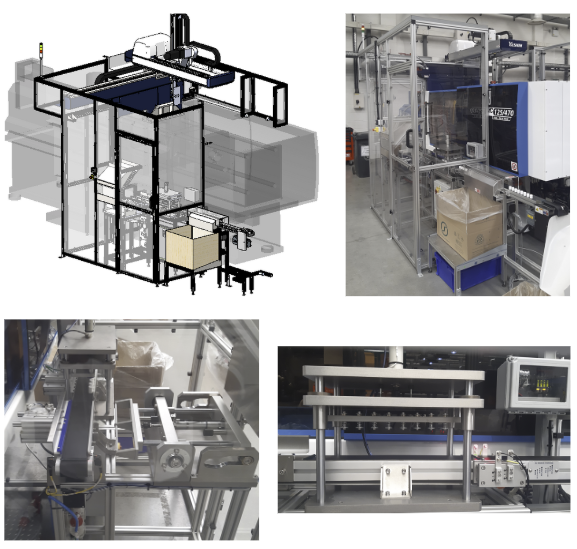Cap Closing Automation Cell
Task
Spectra Packaging tasked us to develop a versatile and cost-effective cap closing automation cell. Spectra is a leader in bespoke cosmetic, toiletries and personal market packaging with a business that is tailored to short batch production runs. The goal was to create a system capable of closing a variety of flip-top lids, accommodating for these shorter production runs. Additionally, the system needed to ensure that caps were fully closed and reject parts that weren’t, all while being compact enough to fit within a limited workspace.

Solution
To meet these needs, the team designed an automation system that integrated with, and utilized the Yushin robot PLC as the control of the cell. The system was structured as follows:
- Yushin robot to take parts from the mould tool.
- A Conveyor system would index the parts through the different stations of the system.
- Pneumatic cap closing station & tamp station were designed with modular ‘change parts’ tooling that could be easily reconfigured for different products.
- Fibre sensor quality check station to confirm the lids have been closed fully.
- Air blast reject station to reject any parts failing the cap close quality check.
- Fibre sensor part counting to accurately count the number of good parts transferred into the box.
The system was designed for ease of operation, requiring only intermittent attention from a single operator to replace the full boxes.
Result
The automation system delivered significant improvements in operational efficiency. By eliminating the need for a secondary operation to close caps, the system saved valuable resources and labour costs whilst the consistent and reliable cap closing process maintained Spectra’s high product quality. Moreover, the successful installation and training of the first Yushin robot at the customer site marked a significant milestone for the company.
The new system provided the flexibility needed to meet the business needs, ensuring that the customer could adapt the machine to future product variations without the need for alternative, expensive, in-mould cap closing tooling.
Challenges
Challenges that were overcome during the development of the system:
- Cap Behaviour Variability: Caps behaved differently depending on their temperature. Hot parts out of the mould tool required the tamp fixture to apply more force in a much more precise location to successfully close the caps. A centring jig was added to ensure the correct alignment of the caps during the closing process.
- Machine Flexibility: The wide variety of potential customer parts required the automation cell to be as flexible as possible whilst being cost effective. A clear and defined range of cap sizes had to be determined to ensure the system’s capabilities were well understood. This involved careful consideration of all defined future product changes.
- Economic Quality Checking: The requirement to detect a 0.2mm lid position variation on transparent parts without the use of a vision camera proved difficult. Through in-house bench testing a solution using multiple fibre sensors with fine adjustment proved successful, which significantly reduced the overall costs for the project and Spectra.
By using a modular, flexible approach, the team was able to design an automation system that was not only cost-effective but also adaptable to future needs. The automation cell’s simplicity in operation, led to a successful deployment. The system reduced manual labour, ensured consistent quality, and provided the customer with a scalable solution for varying cap sizes, ultimately improving production efficiency.
Key Technology Partners
